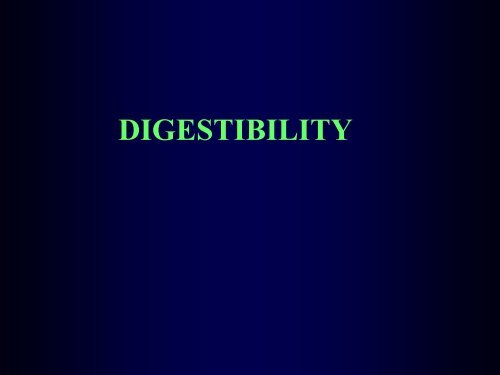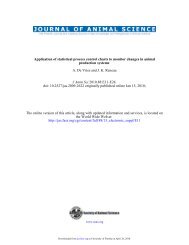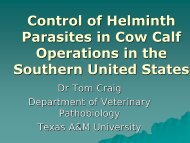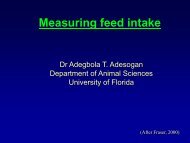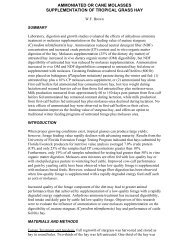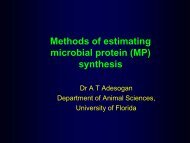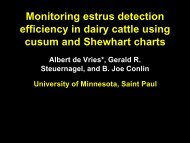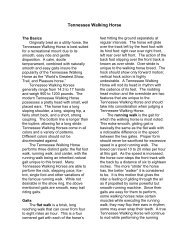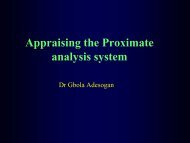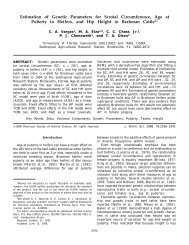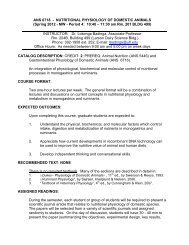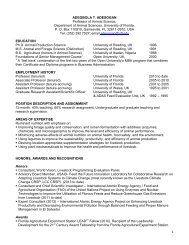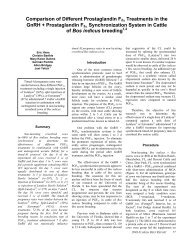Digestibility - Department of Animal Sciences
Digestibility - Department of Animal Sciences
Digestibility - Department of Animal Sciences
You also want an ePaper? Increase the reach of your titles
YUMPU automatically turns print PDFs into web optimized ePapers that Google loves.
DIGESTIBILITY
Apparent v. true digestibility<br />
True digestibility involves correction for endogenous losses,<br />
apparent digestion does not.<br />
Endogenous losses<br />
– Include:<br />
• Sloughed <strong>of</strong>f intestinal cells<br />
• Digestive juices (enzymes)<br />
• Microbial matter<br />
– Quantified by measuring fecal output <strong>of</strong> fasted animals<br />
– Can be 9.8 to 12.9 % DMI<br />
– Should they be quantified?
In vivo digestibility methods<br />
Direct or total/complete collection<br />
Difference method<br />
Regression method<br />
Indirect method
1. Total collection
In vivo digestibility trials in<br />
metabolism crates
In vivo digestibility trials in pens
Total collection<br />
calculations<br />
<strong>Digestibility</strong> (g/kg) =<br />
Nutrient in feed - Nutrient in feces x 1000<br />
Nutrient in feed<br />
Dry matter digestibility (DMD, g/kg) =<br />
DM in feed - DM in feces x 1000<br />
DM in feed<br />
Organic matter digestibility (OMD, g/kg) =<br />
OM in feed - OM in feces x 1000<br />
OM in feed<br />
Can be expressed as a proportion, % or g/kg
<strong>Digestibility</strong> indices that estimate<br />
energy value<br />
Digestible organic matter content (DOMD) (g/kg DM)<br />
= OM in feed - OM in feces x 1000<br />
DM in feed<br />
TDN = DCP + DCF + DNFE + DEE(2.25)<br />
– DCP= Digestible Crude Protein<br />
– DCF= Digestible Crude Fiber<br />
– DNFE= Digestible Nitrogen-Free Extract<br />
– DEE= Digestible Ether Extract (2.25)
2. Difference method<br />
Allows digy calculation for 2 feeds fed simultaneously<br />
Assumptions<br />
– No interaction b/w the digy <strong>of</strong> the feeds<br />
– Must know digy & fecal DM output (DMO) <strong>of</strong> base<br />
feed<br />
Test feed DMD =<br />
Cons<br />
Test feed DMI – (Fecal DMO- Base feed DMO)<br />
Test feed DMI<br />
– Assumptions may be invalid
3. Regression method<br />
Schneider & Flatt (1975)<br />
Also allows digy. estimation for two feeds<br />
– Feed different ratios <strong>of</strong> the two feeds<br />
– Estimate digy <strong>of</strong> each <strong>of</strong> the ratios<br />
– Fit regression <strong>of</strong> test feed inclusion vs. digy<br />
– Extrapolate to estimate digy <strong>of</strong> test feed.<br />
Cons<br />
– Considerable expense and labor for estimating digy<br />
<strong>of</strong> one feed.
DMD (g/kg)<br />
Regression method<br />
800<br />
Base feed digy.<br />
600<br />
400<br />
Test feed digy.<br />
200<br />
20 40 60 80 100<br />
% inclusion <strong>of</strong> test feed in ration
Digy trial issues<br />
Changeover designs<br />
– necessary if period effects are an issue e.g.<br />
• <strong>Animal</strong> physiological changes<br />
• Forage physiological changes<br />
Adaptation period<br />
– Necessary to adapt the animals to<br />
• New feed (microbial population changes)<br />
• Strange equipment<br />
• Strange housing<br />
– 6 – 14 day period is the norm
Marker digestibility trials<br />
Particularly useful for grazing animals<br />
Procedure<br />
– Add indigestible marker to feed eg chromic oxide<br />
– Measure concentration in feed & feces<br />
– Estimate disappearance <strong>of</strong> marker from gut.<br />
E.g. if a feed contains 1% Cr 2 O 3 & feces contains 2%<br />
Cr 2 O3, diet digestibility = 50%<br />
– Since Cr 3 O 2 conc. has doubled, 50% <strong>of</strong> DM must have<br />
been digested
Marker trials contd.<br />
For the digy <strong>of</strong> a specific nutrient,<br />
must also know the % nutrient in feed & feces<br />
%Nutrient = 100 – 100 x % indicator feed X % nutrient feces<br />
<strong>Digestibility</strong> % indicator feces % nutrient feed<br />
Homework:<br />
If lambs are fed a bahia grass diet containing 7%<br />
protein & 1% chromic oxide, and their feces contains<br />
5% CP and 2% chromic oxide. Calculate CP digy.
Marker digestibility<br />
Pros<br />
– Total feces collection not necessary<br />
– Total intake determination not necessary<br />
– Easier, less labor<br />
Cons<br />
– Representative sampling essential<br />
– Accurate estimation <strong>of</strong> nutrient or marker conc.<br />
essential<br />
– Assumes complete excretion <strong>of</strong> marker hence<br />
Recovery <strong>of</strong> marker determines accuracy <strong>of</strong> digy
Marker types<br />
External<br />
– Chromic oxide<br />
– Dysporium<br />
– Polyamide<br />
Can contaminate<br />
forage<br />
Internal<br />
– Lignin<br />
– AIA<br />
– ADF<br />
– n-alkanes<br />
Easier, less labor
Marker issues<br />
Difficulty <strong>of</strong> mixing marker with forages<br />
– Dose cows instead- ( s handling)<br />
Marker migration<br />
– Must not affect feed digy<br />
External markers may contaminate forage
Problems with in vivo<br />
experiments<br />
<strong>Animal</strong> trials are:<br />
– Expensive<br />
– Protracted<br />
– Laborious<br />
– Public concerns<br />
– <strong>Animal</strong> stress ???<br />
Must estimate nutritive value with less animal<br />
dependent techniques
Ideal in vitro methods should be:<br />
– Rapid (one step) & routinely practicable<br />
– Accurate<br />
– Cheap & not laborious<br />
– Repeatable & robust<br />
– Biologically meaningful<br />
– Broad-based (apply to all forage types)<br />
– Handle large nos. <strong>of</strong> samples<br />
– Laboratory-based
Rumen fluid –pepsin in vitro<br />
digestibility (IVOMD)<br />
•Developed by Tilley & Terry<br />
(1967)<br />
•Measures apparent digy in rumen<br />
fluid (48 h) and acid pepsin (48 h)<br />
•Gives accurate predictions <strong>of</strong> in<br />
vivo digy for most forages
Prediction <strong>of</strong> silage OMD in vivo from<br />
different methods (g/kg DM)<br />
Method r 2 RSD<br />
KMnO 4 lignin 21.8 54.6<br />
ADF 32.1 50.9<br />
NDF 45.7 45.5<br />
(M) ADF 55.8 40.9<br />
IVOMD 74.1 33.6<br />
(Givens et al., 1989)
Rumen fluid problems<br />
Variation in Inoculum composition & activity due to<br />
– Host animal diet<br />
– <strong>Animal</strong> species<br />
– Collection time<br />
– Processing (blending vs. filtration)
Rumen fluid problems<br />
Analytical issues<br />
– Maintenance <strong>of</strong> anaerobic media; optimal pH, temp<br />
– High viscosity hinders filtration<br />
– Offensive odors<br />
– Hygiene – (Prevent pathogen infection)
In vivo DOMD<br />
Relationship between in vivo and<br />
in vitro DOMD <strong>of</strong> wheat silage (g/kg DM)<br />
690<br />
670<br />
650<br />
Year One<br />
Year Two<br />
630<br />
r 2 =0.24<br />
610<br />
590<br />
570<br />
550<br />
530<br />
530 580 630 680<br />
Rumen fluid-pepsin DOMD<br />
(Adesogan et al. 1998)
Rumen fluid technique -<br />
problems<br />
Standards needed to correct for variability in rumen<br />
fluid composition & activity<br />
Disregards / inappropriately represents:<br />
– Ruminal outflow (uses a batch process)<br />
– Digests maillard product not digested in vivo<br />
– Associative effects between feeds<br />
– Endogenous secretions<br />
– Post abomasal digestion
Alternatives to Tilley & Terry<br />
1. Rumen fluid – Neutral detergent (Van Soest, 1967)<br />
– More akin to true digestibility<br />
– Gives higher digy. values<br />
– Still requires rumen fluid<br />
2. Feces<br />
– Gives lower digestibility estimates<br />
3. Enzyme- based assays
Prediction <strong>of</strong> DMD in vivo from in vitro<br />
fecal liquor DMD<br />
Spp. <strong>of</strong> feces donor<br />
r 2 range<br />
Ovine 0.33 – 0.98<br />
Bovine 0.77 – 0.97<br />
Equine 0.90<br />
Caprine 0.96-0.97<br />
(Ohmed et al., 2001)
Cell-free enzyme in vitro digestibility<br />
Examples <strong>of</strong> procedures used:<br />
1. Cellulase<br />
2. Neutral detergent- cellulase<br />
3. Neutral detergent-cellulase +gammanase<br />
4. Pepsin cellulase<br />
Amylase pre-treatment important for starch-rich feeds<br />
Gammanase for oil-rich feeds
Relationships between DMD in vivo and<br />
enzyme predicted DMD<br />
Method R 2<br />
Cellulase 0.83<br />
Neutral detergent cellulase 0.94<br />
Acid pepsin – cellulase 0.88<br />
Rumen fluid 0.83<br />
(Bughara & Sleper, 1986)
Prediction <strong>of</strong> in vivo OMD <strong>of</strong><br />
forages from different methods<br />
Method r RSD (%) AE(+)<br />
ND + cellulase 0.90 3.3 0.9<br />
Pepsin + cellulase 0.94 2.6 0.3<br />
(McLeod & Minson, 1982)<br />
Higher analytical error with ND – cellulase technique<br />
may outweigh shorter processing time
Prediction <strong>of</strong> in vivo OMD <strong>of</strong> spring<br />
grass from different methods<br />
Method r 2 RSD<br />
ND + cellulase 76.6 27.1<br />
Pepsin + cellulase 75.9 28.8<br />
Rumen fluid-pepsin 67.0 33.2<br />
(M) ADF 66.9 33.3<br />
Poorer relationships found for autumn grass (r 2 = 13- 20)<br />
(Givens et al., 1990)
Effect <strong>of</strong> enzyme source on cellulase<br />
activity<br />
% DM solubilized<br />
Fungi Herbage Cellulose paper<br />
Trichoderma spp. 57 69<br />
Basidiomycete 48 20<br />
Aspergillus niger 45 10<br />
Rhizopus spp. 35 7<br />
(Jones & Hayward, 1975)
14<br />
C-Casein hydrolysis (mg/ml)<br />
0.5 Co-culture<br />
0.0 0.25<br />
S. bovis<br />
0.0<br />
S. ruminantium<br />
10 20<br />
Time (h)<br />
Commercial enzymes don’t fully simulate microbial<br />
activity <strong>of</strong> mixed rumen microbes
Enzyme method problems<br />
Equations are species-specific<br />
Represent effect <strong>of</strong> a few enzymes<br />
Variability in enzyme activity<br />
– Due to enzyme source & batch
The ANKOM equipment
tube<br />
tube<br />
Ankom digestibility validation<br />
Prediction <strong>of</strong> tube app. DOMD from bag app. DOMD<br />
Prediction <strong>of</strong> tube true DOMD from bag true DOMD<br />
80<br />
y = 0.87x + 4.25<br />
r 2 = 0.83; rsd = 4.04<br />
80<br />
y = 0.99x + 3.61<br />
70<br />
r 2 = 0.93; rsd=2.93<br />
70<br />
60<br />
50<br />
60<br />
40<br />
bag<br />
40 50 60 70 80<br />
50<br />
bag<br />
50 55 60 65 70 75 80 85
ANKOM pros & cons<br />
Pros<br />
– Simplifies filtration, incubation and mixing<br />
– Uses a batch process (& ash-free bags)<br />
Cons<br />
– Bag pore size may allow excess outflow or restrict<br />
microbial colonization<br />
– Bag material & pore size may affect results<br />
• Mon<strong>of</strong>ilamentous cloth – precise aperture<br />
• Multifilamentous cloth – pore size affected by stresses<br />
e.g. dacron
In vitro digestibility summary<br />
Pros<br />
– Predicts in vivo digy more accurately than NDF or<br />
lignin<br />
– Handles several samples & are biologically<br />
meaningful<br />
Cons<br />
– May require fistulated animals<br />
– Labor intensive & protracted<br />
– Plagued by variability in composition & activity <strong>of</strong><br />
inoculum/enzyme<br />
– Doesn’t indicate the kinetics <strong>of</strong> digestion
<strong>Digestibility</strong> references<br />
Chapters 6 – 8 In: D.I. Givens, E. Owen, R.F.E. Axford and H.M. Omed (Editors) 2000,<br />
Forage Evaluation in Ruminant Nutrition. CABI Publishing, Wallingford, UK, pp. 113-<br />
134.<br />
Adesogan, A.T, Givens D.I. and Owen. E. Measuring chemical composition and nutritive<br />
value in forages. Field and Laboratory methods for grassland and animal production<br />
research. CABI Publishing. P 263<br />
Tilley, J.M.A. and Terry, R.A., 1963. A two stage technique for the in vitro digestion <strong>of</strong><br />
forage crops. Journal <strong>of</strong> the British Grassland Society, 18: 104-111.<br />
Van Soest, P.J., Wine, R.H. and Moore, L.A., 1966. Estimation <strong>of</strong> the true digestibility <strong>of</strong><br />
forages by the in vitro digestion <strong>of</strong> cell walls. Proceedings <strong>of</strong> , The Xth International<br />
Grassland Congress, Helsinki. Finish Grassland Association., pp 438-441.<br />
Vogel, K.P., Pedersen, J.F., Masterson, S.D. and Toy, J.J., 1999. Evaluation <strong>of</strong> a filter bag<br />
system for NDF, ADF, and IVDMD forage analysis. Crop Science, 39: 276-279.<br />
Wilman, D. and Adesogan, A., 2000. A comparison <strong>of</strong> filter bag methods with conventional<br />
tube methods <strong>of</strong> determining the in vitro digestibility <strong>of</strong> forages. <strong>Animal</strong> Feed Science and<br />
Technology, 84: 33-47.


